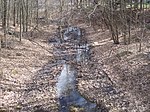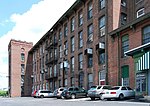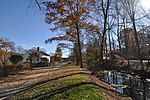Nine Men's Misery
1676 in the Thirteen ColoniesArchaeological sites in Rhode IslandBuildings and structures completed in 1676Cumberland, Rhode IslandEnglish colonization of the Americas ... and 7 more
Geography of Providence County, Rhode IslandHistory of New EnglandKing Philip's WarLandmarks in Rhode IslandNew EnglandPre-statehood history of Rhode IslandRhode Island culture

Nine Men's Misery is a site in current day Cumberland, Rhode Island, where nine colonists were tortured by Narragansett warriors during King Philip's War. A stone memorial was constructed in 1676 and is believed to be the oldest war monument in the United States.
Excerpt from the Wikipedia article Nine Men's Misery (License: CC BY-SA 3.0, Authors, Images).Nine Men's Misery
Lynch Trail,
Geographical coordinates (GPS) Address Nearby Places Show on map
Geographical coordinates (GPS)
| Latitude | Longitude |
|---|---|
| N 41.939444444444 ° | E -71.406666666667 ° |
Address
Cumberland Monastery
Lynch Trail
02864
Rhode Island, United States
Open on Google Maps








